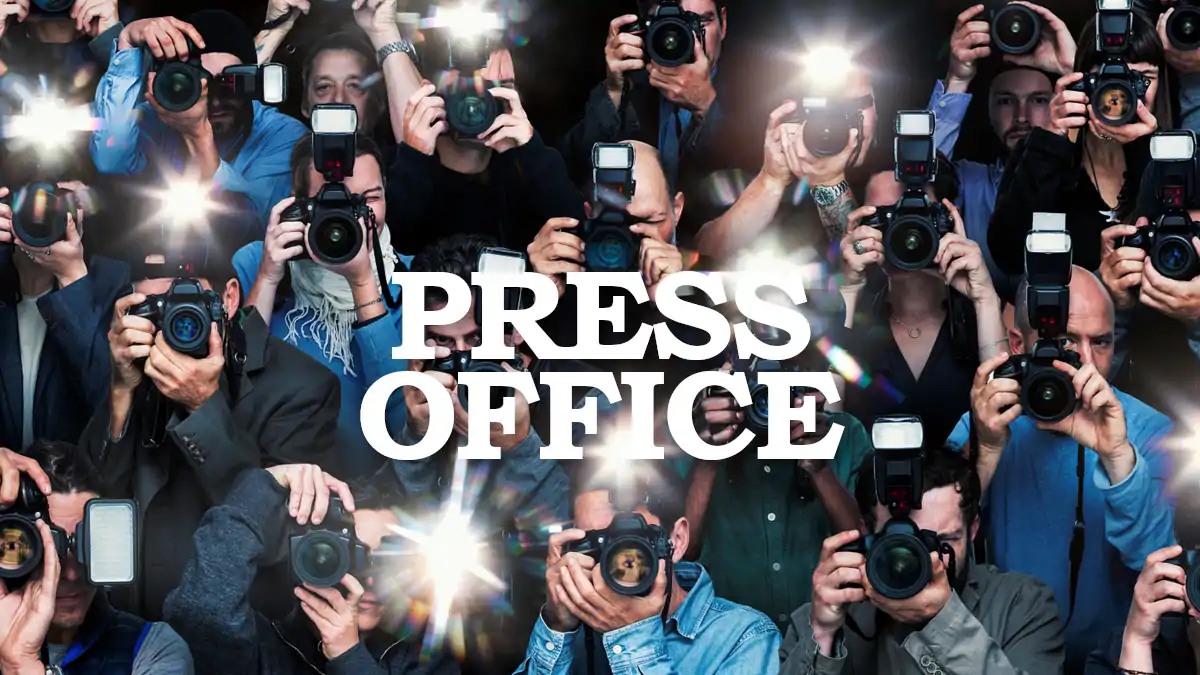A press office is the department responsible for obtaining media coverage, adapting the client’s message, and responding appropriately to journalists’ requests.
This work is carried out through various media outlets such as the internet, print, television, radio, and social media, using various strategies.
By:
Created:
Updated:

In this article, I will explain its functions and tools. Click on the next link to see some case studies by my PR agency.
Looking for a PR agency in Spain?
Send an email:
hola@apablo.com
Table of Contents
Difference between advertising and communication (PR)
Before we delve into the subject, it’s important to understand that advertising and communication are two different things 😊
They may seem similar, but they are entirely different concepts.

- Advertising is managed by advertising departments and involves obtaining exposure in exchange for payment to a media outlet (including social media).
- Communication (or PR) is managed by editorial departments and involves obtaining exposure by providing some form of content to the media outlet (such as data, an opinion, information about a product, and more).
It’s crucial to understand this distinction because a press office does not engage in advertising. A press office engages in communication and PR.
Both may have a similar objective (to gain exposure), but the approach to achieving that objective is completely different.
Types of Press Office
Press office, communication agency, PR office, PR agency… all these terms refer to the same activity. The work is often carried out by journalists.
A press office can be in-house (with hired staff) or external (by hiring a PR agency). This depends on the interests of each case.
Both options have their pros and cons:
An internal department may have more control over the communication processes…
…but hiring an agency has the benefit of a better database and experience with numerous clients in different areas.
This is quite common, and it often happens that the experience with one client ends up being implemented for another 😊 (in a different industry, of course).
On the other hand, press offices of all types and sizes can be found.

Large agencies with million-dollar contracts, medium-sized agencies with more affordable prices, and freelance professionals (like myself) who offer truly unbeatable prices.
And the service is the same.
Functions of a Press Office
The main objective of a press office is to obtain media coverage, shape the client’s communicative message, and assist journalists by responding to their requests.
Through these efforts, the client gradually gains credibility and trust within society while conveying their vision and values.
The fruits of this work are best identified when it is a sustained service over the medium and long term.
Creating and Developing a Narrative
It involves describing in words and making coherent the client’s communicative message over the medium and long term.
All new ideas added to this narrative must be consistent with it.
It doesn’t make sense to say one thing in a newspaper and something completely different in a television interview, right?
A very common example can be seen in political communication.
When a politician changes their opinion, their press office has to create a narrative bridge that gives meaning to this change of mind, without giving citizens the impression that they are lying.
In essence, it is about maintaining a positive and coherent message and trying to make sense of any new argument or circumstance that may arise.
I used the example of politics, but this constantly happens in companies 😉
Once the general narrative is created, the press office (or PR agency) develops all the relevant informational content.
I’m mainly referring to texts (I’ll explain the tools below).
These can be content proposals, interviews, result reports, product presentations, independent interpretations, and countless other ideas.
Informing Journalists from a press office
Journalists often specialize in specific sectors.
While any journalist may be able to write about anything at a given moment, the trend is towards specialization.
That’s why one of the functions of a press office is precisely to know who these journalists are.
Identify them, send them information, and maintain a friendly and ongoing relationship with them over time.
This information sharing work is proactive and regular.
It is advisable to inform journalists about any updates or developments regarding the client, and if there are none, suggest new content ideas that may be of interest to the media.
Handling Requests from Media, Journalists, and Influencers
Sometimes, the client may be the subject of news, part of them, or a legitimate voice to provide an opinion on a current story.
In such cases, a media outlet, journalist, or influencer may directly contact the client.

The press office handles these requests and internally coordinates them with the client’s relevant department.
The objective is to create an answer that fulfills the media or journalist’s request, aligns with the client’s usual communicative narrative, and presents a positive image of the client.
Identifying Opportunities for Media Coverage
In addition to handling requests, the press office constantly seeks opportunities to gain media coverage.
A very clear example of this was witnessed during the COVID-19 crisis.
Overnight, we saw numerous companies on television explaining how they were managing the situation or showcasing health-related products for virus protection.
While this may be an exaggerated example due to its obviousness, it effectively illustrates the point I want to make.
Another example could be leveraging the imminent approval of a law in an industry where the client specializes.
Listening and Monitoring Tasks
To control communication and create a strong message, it is crucial to know what is being said about the client.
That’s why the function of listening and monitoring is highly important.

Monitoring what is being published, assessing whether the press coverage is positive or negative, and paying attention to comments (this last point is extremely important).
All of them not only help shape future messages but also allow for the direct implementation of new ideas into the product.
There are multinational companies that actively read comments on social media to gather ideas.
When it comes to information about product testing, the opinion of a journalist (or influencer or opinion leader) holds immeasurable value for a client’s future decisions.
Of course, if the results are not favorable, it is necessary to reconsider the work being done.
Within this listening and monitoring function, there is also the supervision of content on the client’s own channels (website, social media, newsletters, etc.).
Crisis Communication handled by a press office
Crisis communication involves working on a message that mitigates the negative effects of bad press.
This bad press can arise from various issues.

A hefty fine, a defective product, or inappropriate statements that could quickly make headlines.
Therefore, a PR consultant also focuses on redirecting the discourse and making it believable and convincing.
Behind every crisis, there is also an opportunity, and there is no better tool than communication to identify and leverage it.
Learn more about crisis communication.
Organizing Events and Conferences
A communication agency can also organize or assist in various types of events: press conferences, trade fairs, online presentations, and more.
One of the key functions is, of course, media advisory and coordination.
However, there are many press offices that also handle venue selection, sound technicians, presenters (if applicable), lighting arrangements, and even catering.
In the end, image is also a form of communication. And as you know, projecting a good image is essential in any event.
However, all of this depends on the specific case.
I have worked with clients who handled all the event organization, and my sole responsibility was to invite the media.
I have also worked with others who required more assistance in the overall event organization.
Protocol and Institutional Relations
A press office can work on its client’s institutional relations and serve as a communication bridge with other entities that share a common interest.

For example, a union that wants to have a meeting with the government or a political party to discuss a specific issue.
The press department can write a letter to the relevant politician or the leaders of opposition parties.
These efforts often turn out best when working with associations or collectives, but personally, I have been able to arrange meetings with parliamentary groups in the Congress for some of my clients.
However, it’s not limited to politics. It can also involve important meetings with stakeholders, other institutions, or companies that share a concern or any other type of issue.
Achieving these meetings is not always easy, but it can certainly be one of the functions of a PR professional.
Spokesperson Training
Spokesperson training involves coaching the individual who will represent and speak on behalf of a client, ensuring they communicate their values clearly and amiably.
Many people may think they would make great spokespersons, but it’s not as easy as it seems, right?

It’s important to know what to say, which is crucial. It’s equally important to learn how to say it effectively.
But perhaps most importantly, understanding what NOT to say is key! 😃
To achieve that, it takes a special talent or a dedicated PR collaborator who takes the time to train the spokesperson.
On a serious note, a communication professional can recognize when a message is inconsistent with the client’s overall narrative.
It’s their role to bring this to the attention of the spokesperson, who should gladly accept the suggestions.
After all, how others perceive us from the outside can be very different from our own perspective.
Content Translation
Carrying out a communication strategy requires translating the content into the language of the corresponding region.
Press releases, media advisories, dossiers, opinion articles…
All of them need to be adapted to the language of the territory where they will be distributed.
Today, many people might think that artificial intelligence takes care of translations.
However, technology still lacks that spark of local knowledge, idioms, and human communication from a specific place.
Not to mention the poor automatic translations that say something different from the original!
Therefore, one of the functions of a press office is undoubtedly the translation of content that will be used in campaigns later on.
Tools used by a press office
To carry out all these functions, a press office relies on several communication tools.

Primarily, it uses office software programs such as Word, Excel, and WordPress, as well as a telephone.
Communication Plan
The communication plan is a strategically valuable document that summarizes the messages, objectives, and actions that the press office will undertake.
It describes the brand’s narrative, values, history, key messages, and the arguments the press office will work with.
Furthermore, the communication plan establishes the objectives that will determine the success of the campaign.
These objectives can take various forms, both qualitative and quantitative.
Additionally, the plan outlines the specific actions that will be taken to achieve these objectives.
Learn more about how to make a communication plan.
Press Release
A press release is a document issued by an organization to communicate news or events to the media.

It can contain news, product launches, study results, statements, or any other journalistic content related to the client.
A well-written press release serves the purpose of providing information, not promoting or advertising, even if its intention is to sell a product.
Remember that we began this article by distinguishing between advertising and communication (PR)?
If you write a press release with an overly commercial tone, it is unlikely to be of interest to the media 😛
In any case, the press release is probably the most common tool used in a press office.
Media advisory from a press office
A media advisory has a similar format to a press release.
The difference is that the content invites the media to attend a specific location, on a particular date and time.
The event can take various formats: it can be a press conference, a presentation, a trade fair, an informal gathering, or any other event where a spokesperson for the client will provide some form of information.
It is common for press photographers and television camera crews to attend these events.
Journalists may ask questions to clarify any issues.
During the event, a press release summarizing its content is usually provided, and sometimes a press kit as well.
Press Kit
A press kit is a compilation of information and visual materials about a specific entity.
It can include text, images, videos, and even product samples.
The information takes various formats, from a printed document to an online folder.
It usually contains more content than a press release and is also better designed.
Its purpose is to present the client in an engaging manner for the media.
Let’s say it’s a usually permanent source of information that is generally referred to.
Media Alert
A media alert is a very brief communication that announces an upcoming event or story.
It is similar to a press release but much shorter and focused on an imminent issue.
A press release contains more information than a media alert.
Q&A (Questions and Answers)
A Q&A document is a text in which a journalist asks a series of questions that are to be answered by the client.
Some of the answers can be generic, as they address commonly asked questions.

This document is used on numerous occasions and provides answers to questions about a current issue, the client’s perspective or purpose, or any topic on which the client has something to say.
It is typically a written document, although it can also take the form of a video or audio format.
Product Sample Delivery
A press office may send a series of product samples to different journalists for them to conduct reviews.
These reviews are later published.
If the products are physical (cosmetics, electronics, etc.), they are typically shipped via courier.
If the products are digital, care must be taken to avoid sending the same reference to two different journalists.
Press office One-to-One
Within a press office, the term “one-to-one” refers to a private meeting between a journalist and a representative of the client organization.
These types of meetings are a way for a journalist to understand the vision and values of an entity.

This allows media professionals to put a face to the organization they are reporting on.
A one-to-one meeting can result in a feature story, an interview, or an article.
Furthermore, the journalist who has arranged the meeting will gain insight into the individuals behind the information reaching the newsroom (putting a face to them).
It is also an opportunity to reveal an exclusive story or casually discuss the next steps the client organization may take.
Clipping or Coverage Report
A clipping or coverage report is a document that details the media appearances that the client has received.
It can take various formats, ranging from an Excel spreadsheet to a PDF, as long as it is easy to navigate through the various obtained impacts.
The frequency of the report can be monthly or annual, depending on the client’s media coverage volume.
A coverage report or clipping usually includes the following information:
- Publication date
- Media outlet
- Type of media (national, specialized, regional, etc.)
- Headline
- URL or link to the digitized content
- Whether the coverage includes a link to the client’s website or not
- Media audience or Domain Authority (DA)
- Tone of the coverage (positive, neutral, or negative)
And any other fields that the client may require.
In some cases, a brief summary of the content is included.
Discover 30+ analysis ideas that a press clipping should inform about.
Between you and me, it’s the typical task assigned to interns when they start working 😛
Databases used in a press office
A database is a list of journalists that a press office uses to distribute its information. It is one of the key components on which a PR agency relies.

So far, we have listed numerous communication tools, remember?
Press releases, media advisories, press kits, media alerts, Q&A documents, and others need to be sent through some channel to the media.
And that contact information is stored in databases.
Databases can come in different formats, ranging from Excel files to cloud-based platforms.
In my experience, I prefer Excel, but each person has their own preference 😊
At a minimum, a database typically includes the following information:
- Journalist’s name
- Email address
- Phone number
- Media outlet they work for
- Type of media outlet
- Specialization or topics they cover
- Media outlet address
- Journalist’s social media profiles
However, just like with clipping, everyone has their own way of doing things.
Objectives and Strategies at a press office
A press office can establish numerous objectives and employ a variety of strategies to meet the needs of its clients.

That’s why I’ve created this informal list of common scenarios.
It serves to illustrate how the work varies depending on the client, although it certainly doesn’t cover all possibilities.
The Large Entity
Working with a large entity often involves a conservative and low-risk communication approach.
It’s a “by the book” type of work, as they say.
This is because large entities already generate media coverage on their own, such as significant product announcements, financial reports that interest shareholders, worker strikes, and more.
Coverage is generated naturally due to the entity’s inherent interests, and the press office primarily focuses on message management rather than actively seeking coverage.
However, a small mistake can trigger a major communications crisis.
The Medium-Sized Client at a press office
Working with medium-sized entities presents a greater challenge.
They constantly face the media dominance of their larger competitors.
As a result, the work becomes much more meticulous and strategic.
It involves navigating the omnipresence of larger entities.
While medium-sized entities do generate news and coverage, they often struggle to surpass established entities that can overshadow their plans with a single headline.
The Small Client
Working with small entities poses the ultimate challenge but can also be the most rewarding.
Many people, including journalists, may not even be familiar with them.
That’s why it’s crucial for these clients to have a willingness to try new approaches that break away from tradition.
The goal is to make a small entity known for something in terms of communication and then continue to grow from there.
Finding differentiation is key, and most importantly, being useful to journalists’ work.
If a small client lacks this attitude, there is little that can be done.
Why should you hire a press office?

The reasons for hiring a press office are obtaining media coverage every month, improving reputation, increasing visibility and positioning, monitoring published content, and providing an appropriate response to any crisis.
However, questions always arise:
But does this help me sell more?
I like to compare the work of a press office with that of a lawyer. Let me explain:
Imagine you file a lawsuit and hire a lawyer to win the case.
The lawyer’s job is to do everything possible to help you win the case.
However, even with evidence and a stellar performance, there is always a chance that you may not win the case.
But the lawyer still gets paid.
This situation is very similar to that of a PR agency.
It is possible to have a great campaign, and even with the best efforts, it may not directly translate into sales.
It’s a possibility, and the agency still gets paid.
That’s why it’s important to consider that results are visible in the medium and long term.
Of course, it is possible for a specific action to go well and result in sales, but the most effective approach is a long-term plan.
If you want to sell quickly, it’s best to do advertising (not communication).
Can’t I do all this by myself?
Of course, you can do it yourself. The execution itself is relatively easy.
You just need a computer and a phone.
However, keep in mind that there are thousands of others like you.
There’s no harm in trying it yourself. But it’s a highly dedicated job, and the media industry is fast-paced and transient, with its own language and rules.
There is a lot of confusion about how to do communication and PR.
Many people mistake it for advertising when the work is about being useful to the newsrooms.
A skilled communication professional is always aware of this and knows how to execute a campaign to increase the chances of success.
What if I send press releases through a platform?
In recent years, numerous press release distribution platforms have emerged.
However, I haven’t had a good experience with them, and there are a couple of main reasons for that:
Firstly, these platforms often have a very small number of valid contacts.
The media industry is constantly changing, and journalists frequently switch to different media outlets.
These press release distribution platforms tend to be outdated, which is not the case with a professional press office.
Secondly, some of these platforms employ tactics to make you believe that your press release has received extensive coverage.
They may publish it on blog networks that are often penalized by search engines.
They claim to guarantee publication with a link, but this is not an organic process and can be penalized.
I wrote an article on whether buying links and backlinks is legal, which touches on this subject (in Spanish).
In fact, press releases are not meant to be “published” per se.
That only happens when they are truly newsworthy (rather than promotional) and provide valuable content to the newsroom and the audience’s interests.
You may want to read my opinion on websites for sending press releases.
Can I trust the results of AVE (Advertising Value Equivalent)?
The results of AVE, or Advertising Value Equivalent, should be taken with caution because, in general, they are often inflated.
For clients, this data is not useful at all. It’s a figure that only serves the agency to demonstrate that the service is worthwhile.
I’m being completely honest with you here 😊
I have seen monthly AVE results exceeding 100,000 euros while the client, astonished, hadn’t noticed any change in their positioning, followers, or sales.
In other words, if they had spent those 100,000 euros on advertising, they would have likely achieved much better results.
However, I’m not telling you not to hire a press office.
I’m simply warning you that AVE results often don’t correspond to reality.
A single article with a backlink valued at 700 euros might have a greater impact than an entire campaign with results claiming 100,000 euros in AVE.
Many clients have already realized this and no longer request AVE in their coverage reports.
The concept ‘AVE’ is now know as ‘EMV’ (Earned Media Value). Learn more about Earned Media Value and how to calculate.
Conclusion
I hope this article helps you decide whether or not to hire a press office.
It all depends on your needs, the size of your organization, and your goals.
Having a communication professional on board can lead to truly interesting achievements.
Of course, this requires time, consistency, coherence, and optimism.
So, don’t hesitate to send me an email and request a quote 😊 hola@apablo.com
AI-generated pictures on this post have been created using Bing.

